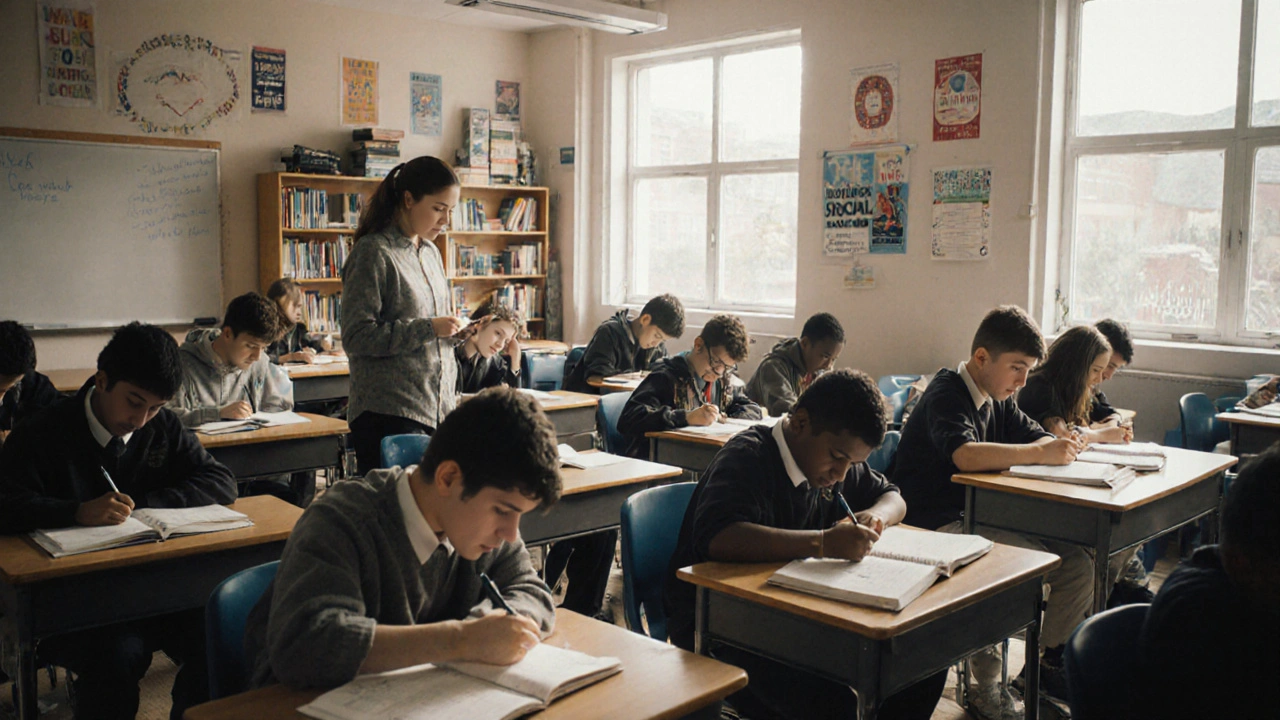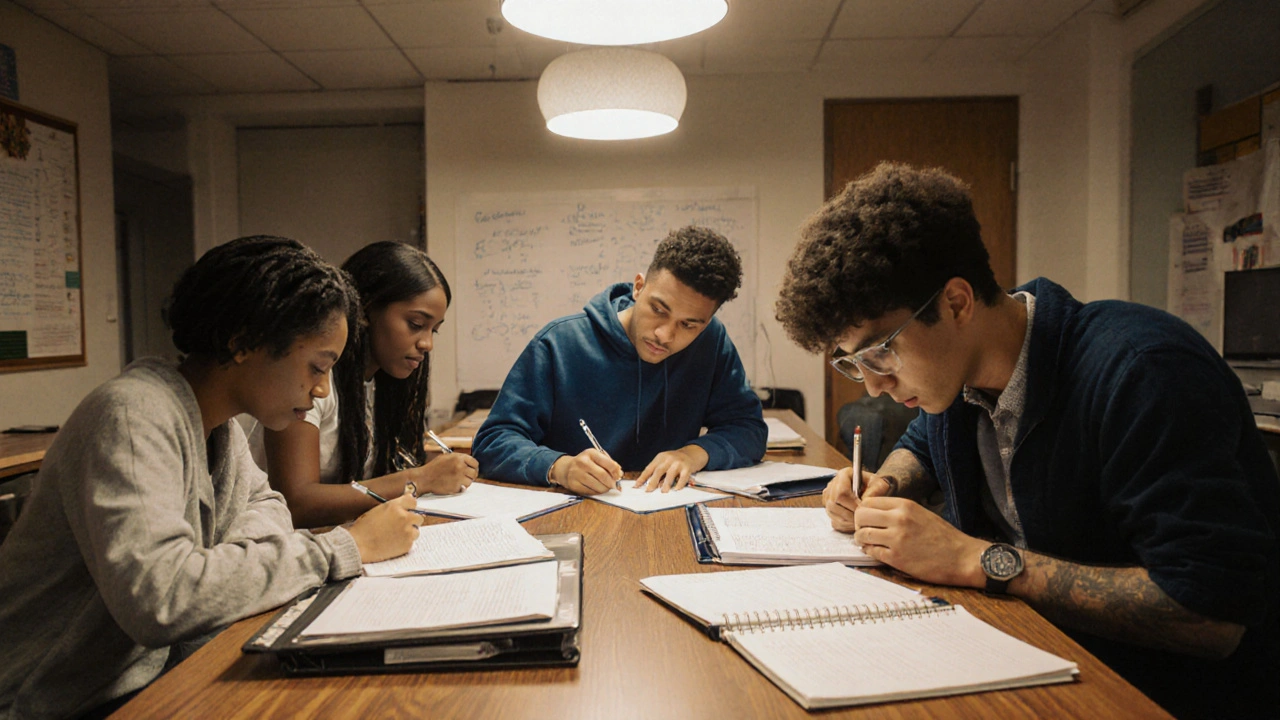What Is Guided Study in High School?

Guided study in high school isn’t just another buzzword. It’s a practical, daily system that helps students actually get through their workload without burning out. Think of it like having a coach sitting beside you while you do your homework-not telling you what to write, but showing you how to start, stay on track, and finish.
What Guided Study Actually Looks Like
Guided study isn’t tutoring. It’s not extra classes. It’s not just sitting in the library with a textbook. It’s a scheduled, supported time where students work on assignments, review material, or prepare for tests-with a teacher, counselor, or peer mentor nearby to answer questions, clarify confusion, and keep them focused.
In most high schools that use guided study, it happens during the school day, usually in a quiet room or designated study hall. Students bring their own work: math problems, history readings, lab reports, essays. The difference? They’re not alone. Someone’s there to help them break down a tough problem, remind them of deadlines, or point them to the right resource.
It’s not about doing the work for them. It’s about making sure they know how to do it themselves.
Why It Works When Other Study Methods Don’t
Most students try to study at home-on their own, after a long day of classes, with distractions everywhere. Phones, siblings, TV, hunger, fatigue. It’s no surprise that many end up staring at a blank page for an hour.
Guided study removes those barriers. It happens in a quiet space, at a set time, with resources nearby. No need to wait until 11 p.m. to start. No need to guess if you’re doing it right. If you’re stuck on a chemistry equation, you can raise your hand and get help in two minutes.
Studies from the National Association of Secondary School Principals show that students who regularly use guided study programs are 30% more likely to complete homework on time and 25% more likely to improve their grades in core subjects like math and English.
Who Benefits the Most?
Guided study isn’t just for students who are struggling. It helps everyone.
- Students with learning differences get immediate clarification without the stigma of being pulled out for special help.
- First-generation college-bound students often don’t have parents who can help with algebra or essay structure-guided study fills that gap.
- High achievers use it to refine their work, get feedback early, and avoid small mistakes that cost them A’s.
- Students juggling jobs or family responsibilities rely on it because they don’t have time or energy to study at home.
It levels the playing field. You don’t need to come from a home with books, tutors, or quiet rooms to succeed. You just need to show up.

How Guided Study Fits Into the School Day
Most schools schedule guided study as part of the regular timetable-usually 30 to 60 minutes a day, 3 to 5 days a week. It might replace a free period, or be built into advisory time.
Some schools rotate it by grade:
- 9th graders get extra support with organization-learning how to use planners, break down long assignments, and ask for help.
- 10th and 11th graders focus on test prep, essay writing, and managing multiple subjects.
- 12th graders use it for college applications, FAFSA forms, and senior research projects.
The structure is simple: students sign in, list what they plan to work on, and check in with staff halfway through. No one’s forced to stay if they’re done-but most stay because it’s easier than going home to distractions.
What Guided Study Isn’t
It’s not a free pass to slack off. You still have to bring your own work. You still have to try. The staff won’t write your essay for you. They won’t do your math homework.
It’s also not a replacement for good teaching. Teachers still assign lessons, grade work, and give feedback. Guided study just gives students the space and support to absorb what they’ve learned.
And it’s not just for kids who are falling behind. The most successful students in guided study programs are often the ones who use it to stay ahead-to polish their work, get ahead on projects, or review before exams.
How to Make the Most of Guided Study
If your school offers it, here’s how to use it right:
- Bring something specific-don’t just show up with “I need to study.” Bring your math worksheet, your history outline, your draft essay.
- Ask questions early-if you don’t understand a problem, don’t wait until the last 10 minutes. Ask right away.
- Use the time to plan-if you have a big project due in two weeks, use guided study to break it into steps and set mini-deadlines.
- Build relationships-get to know the staff. They remember who shows up, who asks smart questions, and who’s trying.
- Don’t treat it like a break-no phones, no socializing. This is work time.
The goal isn’t to finish everything. It’s to make consistent progress. One hour a day, five days a week, adds up to five hours a week of focused, supported work. That’s more than most students get at home.

Real Results from Real Schools
In Asheville High School, guided study was introduced in 2023 as part of a broader push to reduce student stress and improve graduation rates. Within one year:
- Homework completion rates jumped from 62% to 84%.
- The number of students failing at least one class dropped by 22%.
- Student surveys showed 78% felt less anxious about deadlines.
At a rural school in Georgia, guided study helped close the achievement gap between students with and without access to internet at home. Students without Wi-Fi could still access digital resources on school computers during guided study time.
It’s not magic. It’s structure. It’s access. It’s time.
What If Your School Doesn’t Have Guided Study?
Many schools still don’t offer it. But that doesn’t mean you can’t create your own version.
Start a study group with 3-4 classmates. Pick a time after school or on weekends. Assign one person to lead each session-just make sure everyone brings something to work on. Use a timer: 45 minutes of quiet work, then 10 minutes to ask each other questions.
Ask a teacher if they’d be willing to sit in for 20 minutes once a week. Many will say yes if you show up with specific questions.
Libraries, community centers, and even churches sometimes offer free study spaces. You don’t need a fancy program. You just need a plan, a quiet spot, and a little accountability.
Guided Study Is the Missing Link
High school is harder than ever. More homework, more tests, more pressure to get into college. But the tools we give students haven’t changed much.
Guided study fixes that. It doesn’t ask students to be perfect. It doesn’t blame them for distractions. It just gives them the time, space, and support to do the work they already know they need to do.
If you’re a student, use it. If you’re a parent, ask your school if they offer it. If you’re a teacher, consider starting it. It’s not about fixing students. It’s about fixing the system so students don’t have to fight it alone.
Is guided study the same as tutoring?
No. Tutoring is one-on-one help with a specific subject, usually outside of school hours. Guided study is a group setting during school time where students work on any of their assignments with support available. It’s not focused on re-teaching material-it’s focused on helping students apply what they’ve already learned.
Do I need to be struggling to join guided study?
No. Guided study is for everyone. Students who are doing well use it to refine their work, get feedback before turning in assignments, and stay ahead. It’s not a sign of weakness-it’s a smart habit.
Can guided study help with college applications?
Yes. Many schools use guided study time in 12th grade to help students work on college essays, fill out FAFSA forms, and organize recommendation letters. Staff often include counselors who can review applications and give feedback.
How often should I attend guided study?
Aim for at least three times a week. Even 30 minutes a day adds up. Students who attend regularly see better grades and less stress. You don’t need to go every day, but consistency matters more than duration.
What if I don’t know what to work on during guided study?
Start by reviewing your planner or digital calendar. Look at upcoming deadlines. If you’re unsure, ask the staff for help prioritizing. They can show you how to break big tasks into smaller steps. It’s okay to start small-even just organizing your notes counts as progress.
Wilda Mcgee
November 13, 2025 AT 21:43Guided study is the quiet revolution no one talks about. I saw it work in my niece’s school-kids who used to hide in the back of class started raising their hands, turning in work, even smiling in the halls. It’s not about coddling. It’s about giving kids the scaffolding they never knew they needed. The real tragedy? Schools still treat it like a luxury instead of a basic right.
Glenn Celaya
November 15, 2025 AT 11:58Samuel Bennett
November 16, 2025 AT 18:41you say guided study helps students learn to do work themselves but you literally describe adults doing the work for them by answering questions. this is not self regulation this is babysitting with a title
Jen Becker
November 18, 2025 AT 11:39my brother got kicked out of guided study for asking too many questions. they said he was "disrupting the flow." like what am i supposed to do sit there and stare at my math worksheet until i cry
Ryan Toporowski
November 20, 2025 AT 06:23bro this is literally the only thing that kept me from dropping out of 11th grade. i had no one at home to help me with essays and my teacher was always swamped. guided study gave me back my confidence. 🙌
Madeline VanHorn
November 21, 2025 AT 12:52how is this not just public schools admitting they can't teach? if kids need this much handholding maybe they shouldn't be in high school at all
Rob D
November 22, 2025 AT 07:02in america we have become so soft. in my country we did homework at 3am with no help and we turned out fine. this is just another symptom of the decline
saravana kumar
November 23, 2025 AT 07:06in india we have no such thing. students study alone in crowded homes with no electricity. this system is a luxury for privileged americans. why should we copy it
Chris Atkins
November 24, 2025 AT 07:20i used to think guided study was for losers until i started going. turned out i was just bad at starting. now i finish everything before midnight. no shame in needing a nudge
Franklin Hooper
November 26, 2025 AT 03:30the term "guided study" is a euphemism for institutionalized dependency. it infantilizes adolescents and undermines personal responsibility. the data cited is anecdotal at best and statistically insignificant without control groups
Jess Ciro
November 26, 2025 AT 15:52they’re using guided study to hide the fact that teachers are underpaid and overworked. if they had smaller classes they wouldn’t need this. it’s a bandaid on a broken system